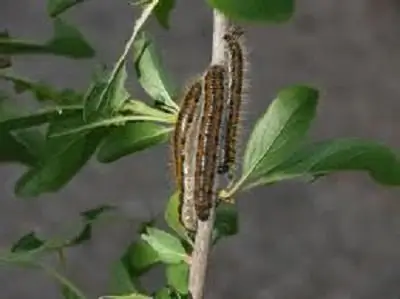In the summer, a lot of butterflies flutter over the flowers, among which there are butterflies that look like cabbage, only with black streaks on the wings. And they call them hawthorns. They were awarded this name for their addiction to hawthorn, and to other trees and shrubs from the rose family. By the way, the hawthorn butterfly, the photo of which is posted below, also belongs to the family of whites, like the well-known cabbage. But unlike the latter, which, in addition to cabbage, also has a passion for horseradish and radish, the former has a more extensive flavor palette. She does not disdain apple trees and pears, mountain ash and plums, bird cherry and apricots, rose hips and lingonberries, and much more. Therefore, for many gardeners and gardeners, the question of how to deal with the hawthorn butterfly is especially relevant.

These butterflies not only "sniff" the flowers and eat the nectar from them, they, most importantly, lay their eggs on the leaves of these plants. And one individual can lay 300-500 eggs, and they, in turn, turn into caterpillars, which are already actively eating buds and leaves to the very veins. And how to deal with the hawthorn butterfly? And hereexperts say that if in the spring before the appearance of the ovary the plants in the garden are not sprayed, then later the caterpillars of this insect can only be fought hand-to-hand. That is, find, collect and destroy colonies of laid eggs.
And you need to think about how to deal with the hawthorn butterfly since the fall. Caterpillars begin to prepare for winter in July. Usually each of them weaves a cocoon, strengthening it with cobwebs. And, most likely, some gardeners found such "houses" in dry leaves, but did not pay attention to them and did not destroy them. And in early spring, the whole process will begin all over again. Butterflies will hatch, which will lay eggs, and after 15 days, caterpillars will appear. And so it will continue indefinitely, and the number of butterflies will constantly grow. Therefore, action must be taken urgently.

Such a harmful hawthorn butterfly. There are different methods of dealing with it, including folk ones. And here decoctions and infusions of henbane, which are sprayed with plants, have proven themselves well. And the remedy is prepared as follows: 1 kilogram of dried henbane or a pound of roots is taken, poured with 10 liters of water and infused for at least 12 hours. Then the infusion is filtered, and for every 10 liters of it, up to 40 grams of grated laundry soap is added. And for a decoction, you need to pour 1 kilogram of dry henbane with 10 liters of water and boil it for 30 minutes. Then the cooled liquid must be filtered, and soap should also be added to it. You can start spraying.

And now about how to fightwith butterfly hawthorn by chemical means. Here, before flowering, trees can be treated with such insecticides: Metaphos, Karbofos, Antio, Metation, Zolon, Nitrafen, Chlorophos and Oleocuprite. Compounds based on diflubenzuron also work well. These insecticides are environmentally friendly and are recommended by the World He alth Organization. Bacterial preparations are effective against hawthorn caterpillars. Plants can be sprayed with these products even in summer, after they come out of the eggs. There are also biological methods of dealing with this scourge. They are insectivorous birds. And by attracting them to gardens, you can contribute to the destruction of insects. So, for example, tits in cold and little snowy winters destroy from 75% of hawthorn caterpillars. Weeds should also be removed, as hawthorns feed on their nectar. This will also help reduce their population.






